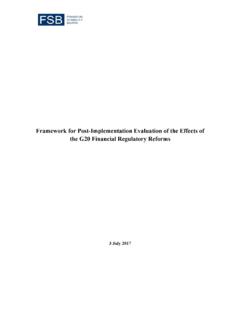Transcription of Basel Committee on Banking Supervision reforms - Basel III
1 Basel Committee on Banking Supervision reforms - Basel IIIS trengthens microprudential regulation and Supervision , and adds a macroprudential overlay that includes capital 1 CapitalContaining leverageRisk coverageRisk management and supervisionMarketdisciplineGlobal liquidity standard and supervisory monitoringPillar 2 Pillar 3 All BanksSIFIsQuality and level of capitalGreater focus on common equity. The minimum will be raised to of risk-weighted assets, after loss absorption at the point of non-viability Contractual terms of capital instruments will include a clause that allows at the discretion of the relevant authority write-off or conversion to common shares if the bank is judged to be non-viable. This principle increases the contribution of the private sector to resolving future Banking crises and thereby reduces moral conservation bufferComprising common equity of of risk-weighted assets, bringing the total common equity standard to 7%. Constraint on a bank s discretionary distributions will be imposed when banks fall into the buffer bufferImposed within a range of comprising common equity, when authorities judge credit growth is resulting in an unacceptable build up of systematic the capital treatment for certain complex securitisations.
2 Requires banks to conduct more rigorous credit analyses of externally rated securitisation exposures. Trading bookSignificantly higher capital for trading and derivatives activities, as well as complex securitisations held in the trading book. Introduction of a stressed value-at-risk framework to help mitigate procyclicality. A capital charge for incremental risk that estimates the default and migration risks of unsecuritised credit products and takes liquidity into credit riskSubstantial strengthening of the counterparty credit risk framework. Includes: more stringent requirements for measuring exposure; capital incentives for banks to use central counterparties for derivatives; and higher capital for inter-financial sector exposures to central counterparties (CCPs)The Committee has proposed that trade exposures to a qualifying CCP will receive a 2% risk weight and default fund exposures to a qualifying CCP will be capitalised according to a risk-based method that consistently and simply estimates risk arising from such default ratioA non-risk-based leverage ratio that includes off-balance sheet exposures will serve as a backstop to the risk-based capital requirement.
3 Also helps contain system wide build up of Pillar 2 firm-wide governance and risk management; capturing the risk of off-balance sheet exposures and securitisation activities; managing risk concentrations; providing incentives for banks to better manage risk and returns over the long term; sound compensation practices; valuation practices; stress testing; accounting standards for financial instruments; corporate governance; and supervisory Pillar 3disclosures requirementsThe requirements introduced relate to securitisation exposures and sponsorship of off-balance sheet vehicles. Enhanced disclosures on the detail of the components of regulatory capital and their reconciliation to the reported accounts will be required, including a comprehensive explanation of how a bank calculates its regulatory capital coverage ratioThe liquidity coverage ratio (LCR) will require banks to have sufficient high-quality liquid assets to withstand a 30-day stressed funding scenario that is specified by stable funding ratioThe net stable funding ratio (NSFR) is a longer-term structural ratio designed to address liquidity mismatches.
4 It covers the entire balance sheet and provides incentives for banks to use stable sources of for Sound Liquidity Risk Management and SupervisionThe Committee s 2008 guidance Principles for Sound Liquidity Risk Management and Supervision takes account of lessons learned during the crisis and is based on a fundamental review of sound practices for managing liquidity risk in Banking organisations. Supervisory monitoringThe liquidity framework includes a common set of monitoring metrics to assist supervisors in identifying and analysing liquidity risk trends at both the bank and system-wide addition to meeting the Basel III requirements, global systemically important financial institutions (SIFIs) must have higher loss absorbency capacity to reflectthe greater risks that they pose to the financial system. The Committee has developed a methodology that includes both quantitative indicators and qualitativeelements to identify global systemically important banks (SIBs).
5 The additional loss absorbency requirements are to be met with a progressive Common Equity Tier 1 (CET1) capital requirement ranging from 1% to , depending on a bank s systemic importance. For banks facing the highest SIB surcharge, an additional loss absorbency of 1% could be applied as a disincentive to increase materially their global systemic importance in the future. A consultative document was published in cooperation with the Financial Stability Board, which is coordinating the overall set of measures to reduce the moral hazard posed by global SIFIs.


















